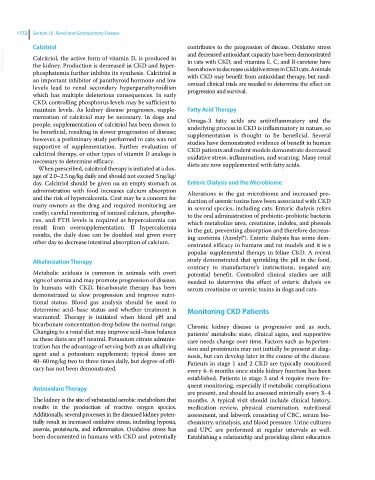Page 1234 - Clinical Small Animal Internal Medicine
P. 1234
1172 Section 10 Renal and Genitourinary Disease
Calcitriol contributes to the progression of disease. Oxidative stress
VetBooks.ir Calcitriol, the active form of vitamin D, is produced in and decreased antioxidant capacity have been demonstrated
in cats with CKD, and vitamins E, C, and B‐carotene have
the kidney. Production is decreased in CKD and hyper-
phosphatemia further inhibits its synthesis. Calcitriol is been shown to decrease oxidative stress in CKD cats. Animals
with CKD may benefit from antioxidant therapy, but rand-
an important inhibitor of parathyroid hormone and low omized clinical trials are needed to determine the effect on
levels lead to renal secondary hyperparathyroidism progression and survival.
which has multiple deleterious consequences. In early
CKD, controlling phosphorus levels may be sufficient to
maintain levels. As kidney disease progresses, supple- Fatty Acid Therapy
mentation of calcitriol may be necessary. In dogs and Omega‐3 fatty acids are antiinflammatory and the
people, supplementation of calcitriol has been shown to underlying process in CKD is inflammatory in nature, so
be beneficial, resulting in slower progression of disease; supplementation is thought to be beneficial. Several
however, a preliminary study performed in cats was not studies have demonstrated evidence of benefit in human
supportive of supplementation. Further evaluation of CKD patients and rodent models demonstrate decreased
calcitriol therapy, or other types of vitamin D analogs is oxidative stress, inflammation, and scarring. Many renal
necessary to determine efficacy. diets are now supplemented with fatty acids.
When prescribed, calcitriol therapy is initiated at a dos-
age of 2.0–2.5 ng/kg daily and should not exceed 5 ng/kg/
day. Calcitriol should be given on an empty stomach as Enteric Dialysis and the Microbiome
administration with food increases calcium absorption Alterations in the gut microbiome and increased pro-
and the risk of hypercalcemia. Cost may be a concern for duction of uremic toxins have been associated with CKD
many owners as the drug and required monitoring are in several species, including cats. Enteric dialysis refers
costly; careful monitoring of ionized calcium, phospho- to the oral administration of prebiotic‐probiotic bacteria
rus, and PTH levels is required as hypercalcemia can which metabolize urea, creatinine, indoles, and phenols
result from oversupplementation. If hypercalcemia in the gut, preventing absorption and therefore decreas-
results, the daily dose can be doubled and given every ing azotemia (Azodyl®). Enteric dialysis has some dem-
other day to decrease intestinal absorption of calcium. onstrated efficacy in humans and rat models and it is a
popular supplemental therapy in feline CKD. A recent
Alkalinization Therapy study demonstrated that sprinkling the pill in the food,
contrary to manufacturer’s instructions, negated any
Metabolic acidosis is common in animals with overt potential benefit. Controlled clinical studies are still
signs of uremia and may promote progression of disease. needed to determine the effect of enteric dialysis on
In humans with CKD, bicarbonate therapy has been serum creatinine or uremic toxins in dogs and cats.
demonstrated to slow progression and improve nutri-
tional status. Blood gas analysis should be used to
determine acid–base status and whether treatment is Monitoring CKD Patients
warranted. Therapy is initiated when blood pH and
bicarbonate concentration drop below the normal range. Chronic kidney disease is progressive and as such,
Changing to a renal diet may improve acid–base balance patients’ metabolic state, clinical signs, and supportive
as these diets are pH neutral. Potassium citrate adminis- care needs change over time. Factors such as hyperten-
tration has the advantage of serving both as an alkalizing sion and proteinuria may not initially be present at diag-
agent and a potassium supplement; typical doses are nosis, but can develop later in the course of the disease.
40–60 mg/kg two to three times daily, but degree of effi- Patients in stage 1 and 2 CKD are typically monitored
cacy has not been demonstrated. every 4–6 months once stable kidney function has been
established. Patients in stage 3 and 4 require more fre-
Antioxidant Therapy quent monitoring, especially if metabolic complications
are present, and should be assessed minimally every 3–4
The kidney is the site of substantial aerobic metabolism that months. A typical visit should include clinical history,
results in the production of reactive oxygen species. medication review, physical examination, nutritional
Additionally, several processes in the diseased kidney poten- assessment, and labwork consisting of CBC, serum bio-
tially result in increased oxidative stress, including hypoxia, chemistry, urinalysis, and blood pressure. Urine cultures
anemia, proteinuria, and inflammation. Oxidative stress has and UPC are performed at regular intervals as well.
been documented in humans with CKD and potentially Establishing a relationship and providing client education

